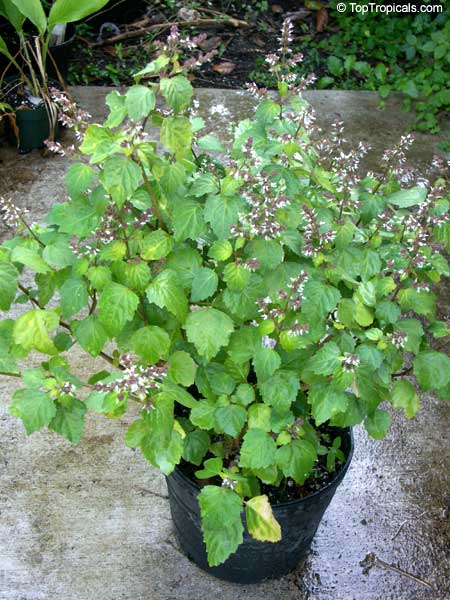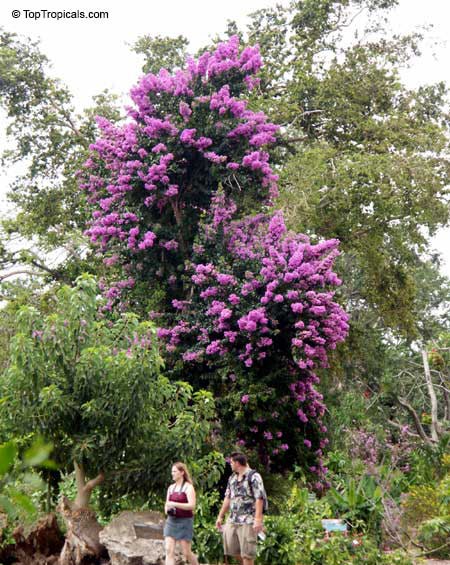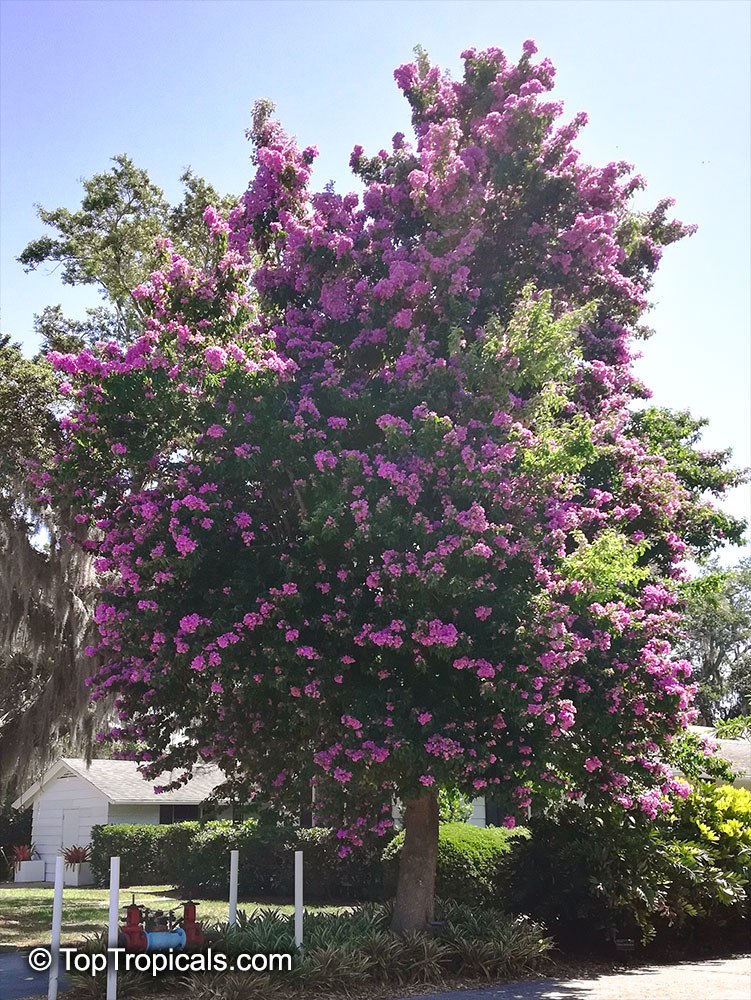Garden Blog - Top Tropicals
Researchers discover what a perfume from Ancient Rome was made of: Patchouli!
⚠️ Get your own valuable Patchouli Plant and always have the heavenly smell with you!
🛒 Plant your own Patchouli
#Perfume_Plants #Remedies #Fun_Facts
🏵 TopTropicals
Patchouli: more than just a pretty scent - every gardener needs it, and heres why
Patchouli, Pogostemon cablin
Patchouli, or Pogostemon cablin, a plant from India that is used to produce the scent Patchouli, offers a wide range of benefits: from its calming aroma to its skin-healing and medicinal properties.
Health Benefits of Pogostemon cablin (Patchouli, Pucha-Pat):
- 📌 Perfumery: Patchouli is well-known for its rich, earthy fragrance, making it a popular ingredient in perfumes, incense, and essential oils. Its strong, musky scent is calming and grounding.
- 📌 Skin Care: The essential oil derived from patchouli leaves is used in skincare products. It's known for its antiseptic and anti-inflammatory properties, helping to soothe skin irritation, acne, and minor cuts or wounds.
- 📌 Stress Relief: Patchouli oil has calming and mood-enhancing qualities, making it effective for reducing stress and anxiety. It's commonly used in aromatherapy to promote relaxation.
- 📌 Anti-inflammatory: Patchouli has anti-inflammatory effects, reducing swelling and discomfort, particularly in arthritis or muscle pain.
- 📌 Digestive Health: The oil is sometimes used to promote digestion and relieve indigestion or bloating. It has mild antispasmodic properties that can soothe the digestive system.
- 📌 Insect Repellent: Patchouli has natural insect-repellent properties, making it useful for warding off mosquitoes and other pests.
- 📌 Antioxidant Properties: Some studies suggest that patchouli oil contains antioxidants, which may help protect cells from damage caused by free radicals, supporting overall health.
Patchouli is not just prized for its unique fragrance - it's a versatile, easy-to-grow herb that thrives with minimal care. This herbaceous shrub is very vigorous and requires little attention. It loves filtered light and just a bit of water to flourish. Even in poor soils, Patchouli remains happy, consistently emitting its uplifting scent and bringing joy to your garden.
🛒 Bring the uplifting fragrance of Patchouli to your garden - grow happiness with every leaf!
📚 Learn more:
Researchers discover what a perfume from Ancient Rome was made of: Patchouli!
#Perfume_Plants #Remedies #Fun_Facts #Food_Forest #Discover
🔴 Join 👉 TopTropicals
Which adenium is ever-blooming? Discover Flamingo Glow
Adenium Flamingo Glow
- If you've visited our Top Tropicals Farm in Sebring, you've surely noticed our two beautiful ever-blooming Adeniums Flamingo Glow - the favorites that always draw admiration (and wishlists) from everyone! Our 2 Flamingo Glow mother plants we have in 7 gal pots are in bloom most of the time, almost year around, except for the Winter dormancy period.
- We're excited to share some great news: these two stunning Flamingo Glow adeniums cross-pollinated and have produced seeds, and their offsprings are now already blooming! The well-sized 3 year old seedlings have inherited the same vibrant, glowing color as their parents, and we now have a few plants available for sale.
- Desert Rose Flamingo Glow is a dazzling Top Tropicals hybrid (A. arabicum x A. obesum) that adds a splash of tropical elegance to any collection. Its soft pink blooms glow like a flamingo at sunset, gradually deepening from delicate blush to rich rose with darker splashes that illuminate the petals. Compact and easy to grow, this variety has a naturally dwarf habit and forms a beautifully rounded caudex, perfect for containers or bonsai-style displays. A living jewel that glows brighter with time!
📚 Learn more: #Adenium
🛒 Claim Your Flamingo Glow and discover more Adenium colors
#Container_Garden #How_to #Shade_Garden #Adenium
🔴 Join 👉 TopTropicals
Discover the health benefits of Katuk: a Superfood for your mind and body
Katuk,Tropical Asparagus - Sauropus androgynus
- 🌿 Katuk, or Tropical Asparagus (Sauropus androgynus), is a delicious leafy vegetable popular in South and Southeast Asia. Its young shoots, often referred to as tropical asparagus, are highly prized for their taste and high yields.
- 🌿 In Vietnam, Katuk is commonly cooked in soups with crab meat, minced pork, or dried shrimp, while in Malaysia, it’s stir-fried with egg and dried anchovies.
- 🌿 The plant is unique for being one of the few plants that contains vitamin K. It’s also rich in folate, vitamin K, and lutein - nutrients linked to improved memory and reduced cognitive aging.
- 🌿 Katuk thrives in full sun or semi-shade, making it a versatile and healthy addition to your garden or kitchen.
Lean more:
📚 Tropical Asparagus, Katuk: Grow your own food
📱 How to cook with Katuk
🛒 Add Katuk Superfood to your edible garden today
#Food_Forest #Remedies #Discover
🔴 Join 👉 TopTropicals
Fun Fact: what Bougainvillea is thornless and grows as a tree
💜 Bougainvillea arborea is a rare gem with fragrant lavender-pink blooms and no thorns! Its slow, compact growth naturally forms a charming tree shape, and best of all, it doesn’t need pruning—perfect for low-maintenance gardens.
#Fun_Facts #Perfume_Plants #Hedges_with_benefits
🛒 Shop Bougainvillea
#Fun_Facts #Trees
🔴 Join 👉 TopTropicals
How Mangoes can help with diabetes
Colorful Mango fruit on a tray
- A new study shows that eating fresh mangoes may support better blood sugar control. Researchers at the Illinois Institute of Technology found that overweight adults who ate mangoes daily experienced significant reductions in insulin resistance - a key factor in preventing type 2 diabetes.
- Mangoes also improved beta-cell function, helping the pancreas produce and release insulin more effectively. After just four weeks, participants had noticeably lower insulin levels, with no changes in the control group.
- While mangoes are naturally sweet and rich in fiber, portion control and balanced carbs are still important. But when enjoyed as part of a healthy diet, mangoes could be a tasty way to support blood sugar balance and metabolic health.
📚Learn more about #Mango
🛒 Plant a Mango tree and grow your own healthy fruit
#Food_Forest #Mango #Fun_Facts #Discover
🔴 Join 👉 TopTropicals
Why grow Grumichama? Benefits of Brazilian Eugenia Tree - Cherry of the Tropics
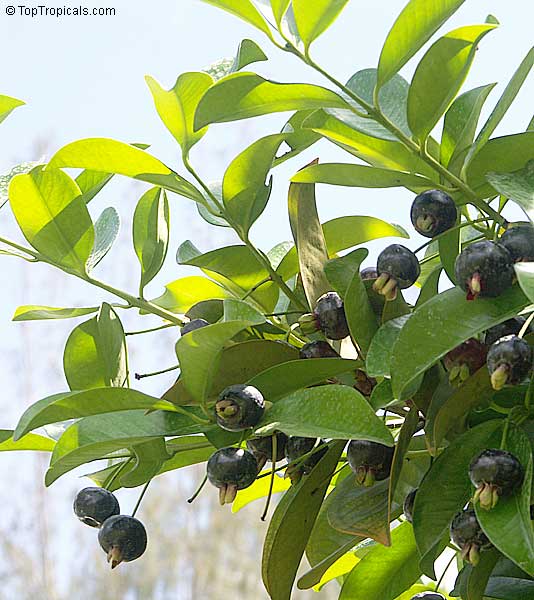
Grumichama (Eugenia brasiliensis), Brazilian Cherry, fruit
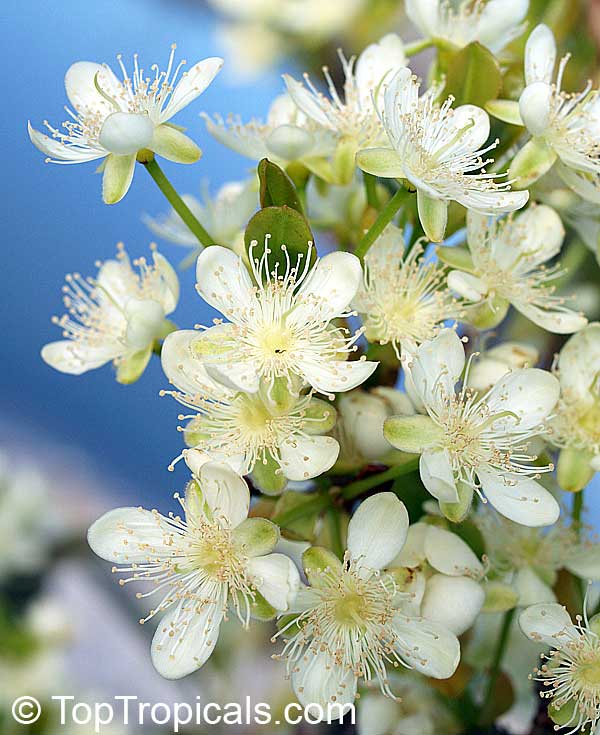
Grumichama (Eugenia brasiliensis), Brazilian Cherry, flowers
- 🍒 Did you know you can grow a tropical cherry right in your backyard? Grumichama (Eugenia brasiliensis), also known as the Brazilian Cherry, is a compact, evergreen fruit tree that's as beautiful as it is delicious.
- 🍒 With glossy green leaves and reddish new growth, it’s an ornamental gem. In spring, it produces white flowers that quickly turn into dark purple, cherry-like fruits - ready to harvest just four weeks after flowering!
- 🍒 The fruits have soft, melting flesh with a flavor similar to northern cherries. Enjoy them fresh, dried, made into jams, or even in baked goods and herbal teas. This is our favorite fresh cherry @TopTropicals!
- 🍒 Grumichama plant grows into a small tree or bush in tropical and subtropical climates. It tolerates light frost.
- 🍒 Fruits in small spaces or containers (5–10 gallon pots)
- 🍒 Perfect for edible landscaping and home orchards. Loaded with fiber and antioxidants.
- 🍒 Whether in the ground or in a pot, Grumichama is easy to grow, stunning year-round, and gives you a sweet, juicy reward.
📚Learn more about Eugenia cherries:
Ten best fruit trees to grow in Florida and Southern landscapes. # 3: Tropical Cherries: Eugenias.
🛒 Plant Grumichama and bring a little bit of Brazil to your garden
#Food_Forest #Fun_Facts #Discover
🔴 Join 👉 TopTropicals
10 reasons why chocolate is actually good for you and how you can grow your own

Chocolate Tree (Theobroma cacao) fruit on a tree
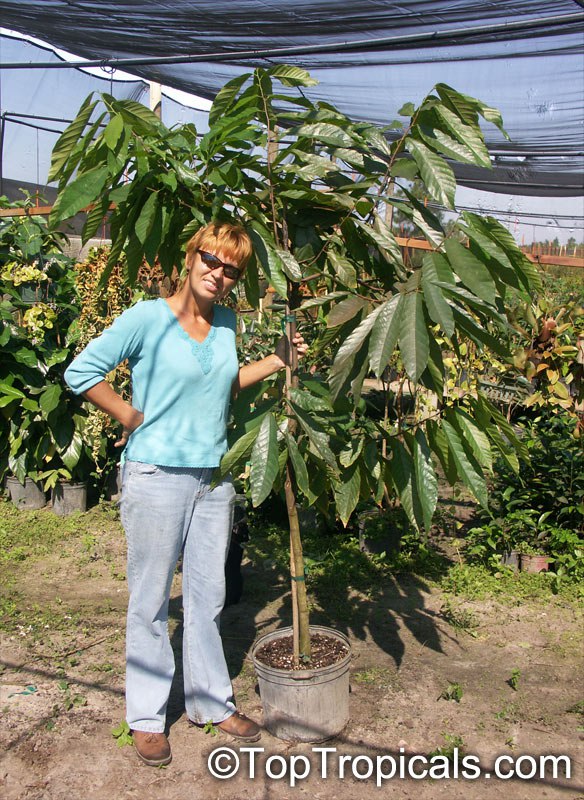
Chocolate Tree (Theobroma cacao) tree in a pot
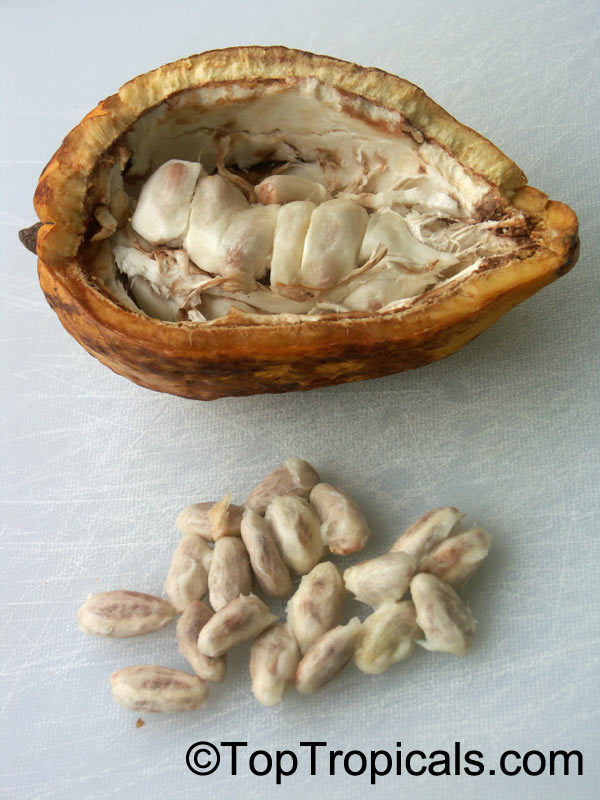
Chocolate Tree (Theobroma cacao) opened fruit with cacao beans
- ☕️ That's right - the source of your favorite sweet treat, the Chocolate Tree (Theobroma cacao) we introduced in earlier post, produces cocoa that's packed with powerful health benefits. Growing your own chocolate tree isn't just fun and rewarding - it's a way to bring a superfood right into your backyard!
- ☕️ Here are 10 reasons why cocoa is a health hero:
- 🍫 Loaded with Antioxidants - Fights free radicals and supports overall cell health.
- 🍫 Heart Healthy - Helps lower blood pressure and improve circulation.
- 🍫 Mood Booster - Promotes feel-good chemicals like serotonin and endorphins.
- 🍫 Brain Power - Flavanols support memory, focus, and cognitive function.
- 🍫 Fights Inflammation - Natural compounds help reduce chronic inflammation.
- 🍫 Supports Blood Sugar Balance - May improve insulin sensitivity.
- 🍫 Glowing Skin - Boosts hydration and protects against UV damage.
- 🍫 Aids in Weight Management - May reduce cravings and support metabolism.
- 🍫 Rich in Minerals - Packed with magnesium, iron, copper, and more.
- 🍫 Good for Gut Health - Acts as a prebiotic to feed good bacteria.
☕️ With all these benefits, why not grow your own source of chocolate? Plant a Theobroma cacao tree and enjoy the magic of harvesting your very own cocoa pods. It's not just a tree - it's a conversation starter, a wellness booster, and your personal chocolate factory in the making.
🛒 Get your Chocolate Tree today and grow your own goodness
#Food_Forest #Fun_Facts #Discover
🔴 Join 👉 TopTropicals
What is better than Apricot? Tropical Apricot!
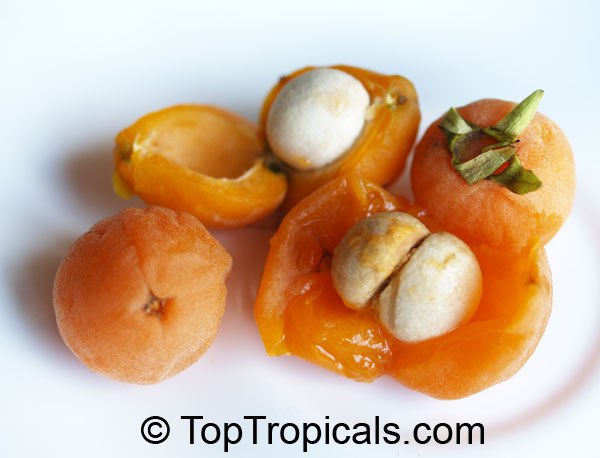
Pitomba, Eugenia luschnathiana - The Tropical Apricot Tree fruit

Pitomba, Eugenia luschnathiana - The Tropical Apricot Tree fruit
- 🍑 Looking for a small, ornamental fruit tree with big flavor? Pitomba (Eugenia luschnathiana) - The Tropical Apricot Tree - is a Brazilian gem that's as beautiful as it is delicious.
- 🍑 This slow-growing evergreen reaches 15-20 feet, with glossy dark green leaves and a striking light brown trunk. In spring, it bursts into white and yellow flowers, followed by apricot-colored fruits ripening from May to July.
- 🍑 The fruit is juicy, aromatic, with a flavor and texture similar to apricots. Rich in vitamin C, minerals, and dietary fiber, Pitomba is perfect eaten fresh or turned into jams, jellies, and juices.
- 🍑 Pitomba grows best in full sun, likes acidic soil, and appreciates regular water and feeding. Whether in the ground or in a pot, it’s a stunning and fruitful addition to your edible landscape.
- 🍑 Why grow Pitomba?
🟡Unique tropical fruit with apricot-like flavor
- 🟡Beautiful, compact tree for small yards or containers
- 🟡Fruits in 2–3 years from seed
- 🟡Cold-hardy to the upper 20s (°F) once mature. Grows in USDA zones 9–11 or indoors with winter protection
- 🟡Traditional medicinal uses in Brazil for colds and digestive health
🛒 Buy Pitomba to add a small fruit tree with big flavor to your yard
#Food_Forest #Fun_Facts #Discover
🔴 Join 👉 TopTropicals
Date:
Discover 10
best fruit trees to grow
in Florida and Southern landscapes
Q: We recently moved into our new home in Florida, and the property is a great size - 5 acres - but it currently has no trees, just a few palms. I'm looking to plant some productive fruit trees to start building our own Food Forest. What fruit trees would you recommend as a good starting point?
A: With five acres of space, you have a fantastic opportunity to create a fruitful garden that can provide for your family for many years to come. Below are our top recommendations for must-have, easy-to-grow fruit trees that thrive in Florida's climate, grow quickly, and start producing right away.
1. Mango Tree
Mango trees (Mangifera indica) are a must-have for any Florida garden, embodying the essence of the Sunshine State with their delicious and nutritious fruit packed with vitamins and fiber. These fast-growing, low-maintenance trees thrive with minimal water and are heat-tolerant. Grafted varieties produce high-quality, fiberless fruit in just 2-3 years, while dwarf "condo" mangoes are perfect for smaller spaces or containers. While young trees need frost protection, mature trees handle cold better. Grafted mangoes offer rich taste that you won't find in commercially grown, fibrous varieties, ensuring a sweet and vibrant harvest from your own garden.
2. Avocado Tree
The Avocado tree (Persea americana) is an essential addition to any tropical or subtropical garden. Known for its health benefits and superfood status, it's a favorite fruit that's not only productive but also a beautiful ornamental tree. Some avocado varieties are more cold-tolerant than mango trees, with the ability to survive temperatures below 25F. While many enjoy growing avocado from seed, only grafted trees guarantee quality fruit and immediate production, as seedlings can take 7-8 years to bear fruit. To successfully grow avocado, ensure good drainage by planting on a raised mound (4-6 inches) and keep the soil consistently moist. There are also compact varieties like Wurtz and Fuerte that thrive in containers or small spaces, making them ideal for patios and small gardens.
3. Tropical Cherries
Tropical cherries, such as Cherry of the Rio Grande (Eugenia aggregata), Grumichama (Eugenia brazilensis), Pitomba (Eugenia luschnathiana), and Black Surinam Cherry (Eugenia uniflora var. Lolita), are popular and easy-to-grow fruit trees that offer fast growth and excellent fruit production. These compact, versatile trees thrive in both the ground and containers, starting to produce fruit almost immediately. Eugenias are low-maintenance, requiring minimal water, thriving in various soil types, and being pest-free. They are heat-tolerant and can endure cool winters, surviving light frosts. Birds love the fruit, but don't worry - there will always be plenty for everyone.
4. Barbados Cherry Tree
Barbados Cherry (Malpighia glabra), also known as Acerola, is a tropical cherry renowned for having the highest vitamin C content of any fruit. This nutrient-packed fruit is perfect for jellies, jams, and freezing without losing its vitamin C. The Barbados Cherry is a fast-growing, dense shrub that fruits multiple times a year, providing abundant harvests for gardeners seeking quick results. It thrives in alkaline soil, tolerates drought, and is relatively cold-hardy, withstanding light freezes. Birds love the fruit, making it a great addition to wildlife-friendly gardens. The dwarf variety, Nana, with its small leaves and fruit, is perfect for containers, borders, or even bonsai, adding ornamental value to any space.
5. Noni Tree
The Noni Tree (Morinda citrifolia) is a top superfood plant that makes a fantastic addition to any Southern garden. Known for its numerous medicinal benefits, Noni fruit offers anti-inflammatory properties, relief from arthritis, and support for conditions like diabetes, metabolism, and weight loss. It's even believed to help fight cancer. Noni trees grow quickly and begin producing fruit within 2 years from seed. This tough, resilient plant thrives in poor soil, endures summer heat, and withstands drought conditions. Despite its tropical appearance, Noni is surprisingly cold-hardy, recovering well after leaf damage in cooler weather. In addition to its health benefits, the Noni tree has ornamental value, with large, waxy leaves and unique fruit, where the flower appears to grow directly on the fruit!
6. Macadamia Nut Tree
The Macadamia Nut Tree (Macadamia integrifolia) is a fantastic addition to any garden, allowing you to grow these delicious, high price tag, nutrient-rich nuts right at home. These trees are cold-hardy, grow quickly, and thrive in all Florida soil types. Once established, they are productive and can tolerate both flooding and drought. Older trees can survive colder winters, while young trees need protection from temperatures below 25-26F. Macadamia trees like plenty of water and a special fertilizer program, including liquid fertilizers and microelements, to ensure healthy root development and optimal production. Aside from being rich in healthy fats, vitamins, and minerals, macadamia nuts offer numerous health benefits, such as improved digestion, heart health, weight management, and blood sugar control. They are also packed with tocotrienols - antioxidants which may protect against cancer and brain diseases.
7. Papaya Tree
Papaya trees (Carica papaya) are resilient, easy to grow, and produce fruit year-round. Rich in papain, a digestive enzyme, papayas are a superfood that promotes gut health. These fast-growing trees often begin producing fruit within the same year they're planted, providing quick rewards for gardeners. Many varieties, especially dwarf papayas, are space-efficient, reaching only 6-8 feet tall while still yielding large crops, making them perfect for small gardens. Surprisingly hardy for a tropical plant, papayas can withstand light freezes and strong winds (tested in hurricanes!). While they are self-fertile, planting 2-3 different cultivars improves pollination and increases yields. "Solo" cultivars, with their smaller, round or oval fruits, are sweet and less susceptible to fruit flies.
8. Guava Tree
Guava trees are beloved for their flavorful fruit, commonly used in juices, drinks, and desserts. Popular varieties include Tropical Guava (Psidium guajava), Cattley Guava (Psidium littorale), Cas Guava (Psidium friedrichsthalianum), and Pineapple Guava (Feijoa sellowiana). Despite their tropical nature, guavas are surprisingly cold-hardy, suitable for cooler climates and occasional frost. These trees thrive in moist conditions and can tolerate some flooding, while their compact growth makes them easy to maintain at any height or shape. Guavas are fast-fruiting, often producing fruit within a year of planting, and even some varieties in 1 gal containers. The dwarf Nana variety is perfect for container culture, producing full-sized fruit in a compact form. Guava trees are mostly pest-resistant, though mealybugs may require occasional treatment with neem oil in humid, rainy areas. Planting multiple guava trees ensures a continuous supply of fresh, juicy fruit and delicious guava juice for everyone to enjoy.
9. Jackfruit Tree
The Jackfruit tree (Artocarpus heterophyllus) is a striking, fast-growing tree known for producing the largest fruit grown on a tree, making it a showstopper in any garden. Nutrient-packed and often used as a meat substitute in South Asian cuisine, Jackfruit is also delicious in curries, chutneys, and as dehydrated chips. These trees grow quickly, have large waxy leaves, and can be maintained at a compact height of 7-8 feet, making them ideal for smaller spaces and easier cold protection. Despite being a tropical species, Jackfruit trees are relatively cold-tolerant and can survive light frost (although on the account of production volume), with established trees being more hardy than seedlings. Jackfruit trees begin producing fruit within 3-4 years from seed, and varieties come true to seed, eliminating the need for grafting, though it can be done for specific varieties.
10. Loquat Tree
The Loquat tree (Eriobotrya japonica) is a fast-growing, drought-tolerant, and highly cold-hardy tropical fruit tree that thrives in Florida gardens. Loquats are heavy producers, with juicy, aromatic fruit that ripens from early spring to early summer, offering a delicious apricot-like flavor. This compact tree is perfect for small gardens, beginners, and those with limited space. Loquats are undemanding, thriving in any soil and withstanding summer heat, winter cold, heavy rains, and occasional flooding. Nutrient-rich, they are high in sugar, acids, vitamins B and C, minerals, and pectin. Loquats are versatile, enjoyed fresh or used in fruit salads, jams, jellies, chutneys, pies, sauces, and even wine-making, and they are often used as a natural sweetener.
